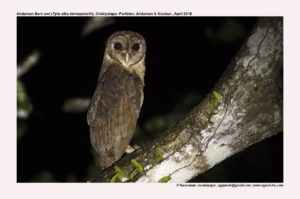
Andaman Barn Owl Tyto alba deroepstorffi
Etymology :
- Tyto : Greek word for Owl derived fromtuto
- alba : Latin word for White
- deroepstorffi : Named after Danish linguist A. de Roepstorff (1842–1883)
Vernacular Names : Hindi:Kuraya, Karailullu, Burichuri, Kash: Rata mogul, Pun: Sunahiriulloo, Bi: Madoosa, M.P.: Ghughu, Ben: Lakshmi pecha,Guj: Revidevi, Mar: GavhaniGhubad, Ori: Lakshmi pecha, Ta: Chavukuruvi, Te: Chavu pitta, Mal: Velimunga, Kan: Goobe, Sinh:Bakamuna
Distribution in India: Resident of Andaman Islands in India
Description: Size of 30-36 cm;26 cm Wing span and tail length of 11 cm. It is a medium-sized, long-legged owl with distinctive heart-shaped face. The nominate race is golden-buff above, with variable light greyish “veil”, and finely streaked, mottled and dotted dark. It has a white facial disc and underparts, sometimes with pale buff on sides of chest and/or fine spotting on breast and flanks. The legs are densely feathered; eyes are dark. It has buoyant, slow, wavering flight, with legs dangling and appears ghost-like. Both the sexes are similar, but female tends to be slightly darker than male. The juvenile is similar to adult, or more heavily spotted. The deroepstorffi species is smaller, darker, with dark brown upperparts, deep brownish-rufous underparts. It lacks the greyish veil, speckled with black and white that all Tyto’s possess. This is the distinguishing feature.
Habitat: It is found in great variety of habitats according to availability of prey, seasonality in temperate regions, and competition from other predators. It is found in open lowlands with some trees, including farmland with hedges, ditches, ponds and banks, roadside verges and related rougher terrain, and young conifer plantations; also around towns, suburbs, villages or more isolated buildings suitable for daytime roosts and nest-sites; sometimes near refuse dumps. It is found from lowland up to 4000 m.
Food habits: It eats small mammals like rats, mice ,rabbits and hares, roosting birds like thrushes , starlings (Sturnidae), sparrows, weavers and finches, reptiles like Gecko, Snakes and lizards, amphibians like frogs and toads , Small fishes and larger insects like grasshoppers, beetles, mantises, moths, wasps and termites; spiders and scorpions. The non-mammalian prey are caught incidentally or opportunistically. Discarded eggshells and faeces of smaller nestlings may also be eaten; occasional chick cannibalism happens at nest. It hunts close to ground in searching flight, undulating and hovering, diving on to prey with talons extended, usually from height of, also commonly from perch; either method used by same bird, or one more than other, depending on habitat type. It is strictly nocturnal, with high auditory acuity in locating prey in complete absence of moonlight. The males take bigger meals after they have finished provisioning their mates and nestlings..
Breeding habits: They breed in April-June in Andaman islands, India. It is normally socially monogamous, but sometimes polygamy seen. The nest site is a natural cavity in tree trunk, stump or large hollow branch, above ground, or in cliff or bank, including sea-cliffs and small, exposed islands, in cave, walls of lava tubes, even in ground; also in hollow of palm tree; wide diversity of artificial structures with adequate room and access also used e.g. old church, tower, castle, ruin, barn, abandoned building, loft, dovecote, windmill, disused water tank, grain silo, around bridges and other large structures, lighthouse, chimney, haystack and unused boat. They lay a clutch of 4-7 eggs, laid 2–3 or more days apart. If first clutch lost, replacement laid is usually smaller. The incubation period is 29–34 days. The male’s only involvement is in feeding female and young. The nestling period is 7–10 weeks. The young are dependent on parents for further 3–5 weeks, and then disperse within 2–8 weeks.